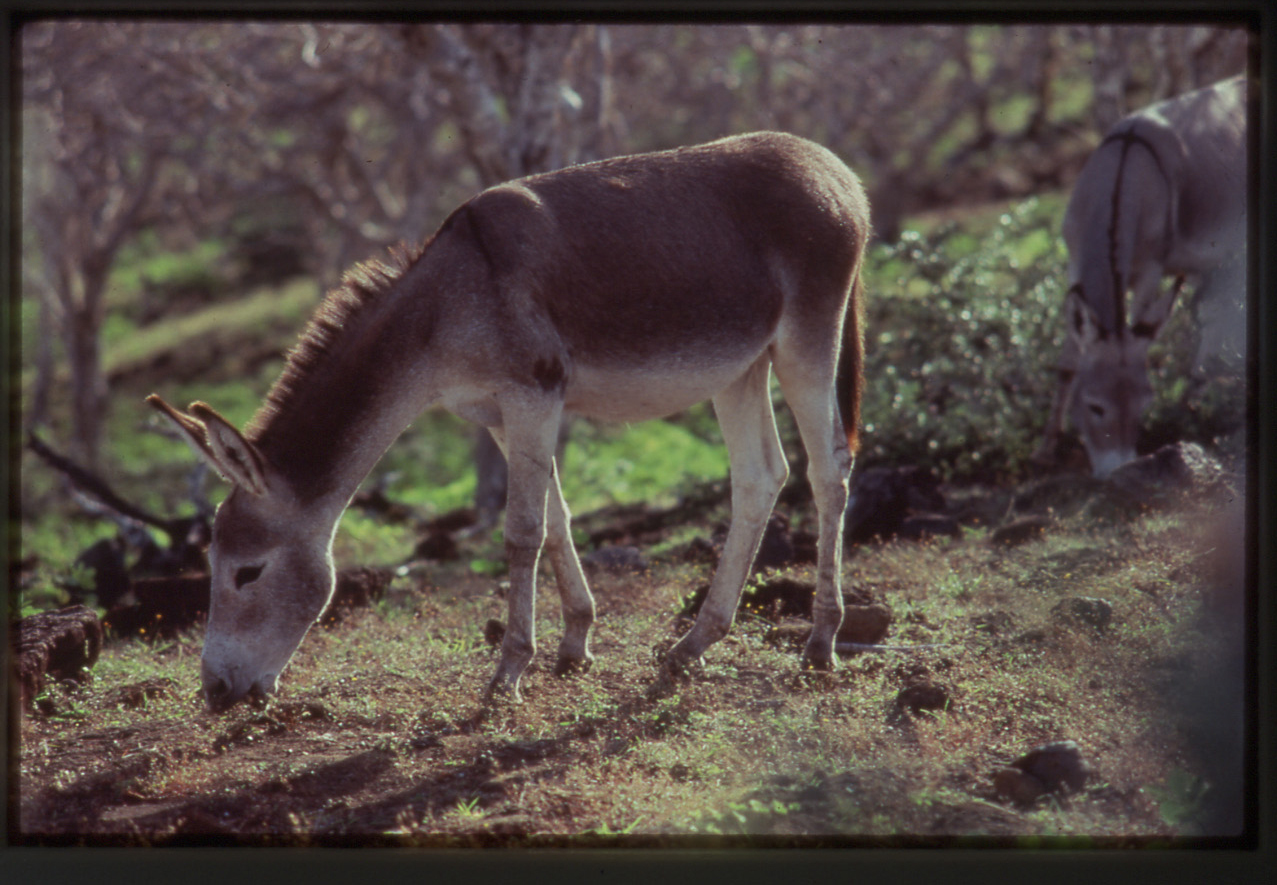Galapagos Species Database
The Galapagos Species Database shares the information about the species from our Natural History Collections.
Equus asinus
Burro, Asno, Donkey

E. asinus is a quadruped, its body is small and robust. It measures between 190-200 cm long with a long straight tail about 40-50 cm long. Height at the shoulder depends largely on the breed of the animal, but it can be between 92-150 cm. They weigh about 450 kg. Their coat can be straight, curly, short or long and woolly. The most common color is gray, but can also be brown and even black or white, with a dark dorsal stripe on the mane and tail. Its head is large with long ears, its mane is short and curled without the characteristic tuft of horses. It has a hoof at each limb, which is longer and narrower than that of the horses. Wild donkeys live in small groups with a dominant male and three to four females. In the wild, they can live an average of 25 years, and domesticated they reach 40 years. The donkeys have a very loud braying which allows them to communicate over long distances.
Donkeys feed on Galapagos plant species, including endemic Opuntia species. They impact tortoise and land iguana populations by trampling nests, and also perhaps through an overlap in diet.
Domain
Eukaryota
Kingdom
Animalia
Phylum
Chordata
Class
Mammalia
Order
Perissodactyla
Family
Equidae
Genus
Equus
Species
asinus
Taxon category: Accepted
Origin: Introduced - established
Year of first record: 1834
Mode of introduction: Intentional
Introduction Pathway: Intentional
Subpathway: Animals for breeding
Introduced status: Naturalized
Invasive status: Invasive
Impact in Galapagos: There is little information regarding the harmful effects that donkeys independently caused in the Galapagos Islands. However, it is known that the donkeys and goats led to a severe degradation of habitat in Isabela, Floreana and Santiago islands. They were the main threat to plant diversity, responsible for the extinction of endemic species like Blutaparon rigidum, in the Santiago Island and Hyptis gymnocaulos (no record in the last 20 years) in the Alcedo volcano. Moreover, they predate on endemic plants such as Opuntia galapageia (Santiago Island), Opuntia insularis and over 180 native species in Alcedo volcano (Isabela Island). The endemic animals like tortoises and land iguanas, are also affected by competition for food and trampling of nests.
Impact elsewhere: The feral populations of Equus asinus are causing harmful and potentially irreversible effects on flora and fauna worldwide. Damages are documented in plants, soils, wildlife, and water quality. Of particular concern is the competition for forage, which adversely affects native species in areas where they occur. An adult donkey consumes about 3,000 kg of foliage per year and wild herds reproduce at an alarming rate which means an increase in foraging intensity. Grazing affects communities of plants that are displaced by other non-native and therefore the animals that depend on them are also displaced, affecting the habitat more. Donkeys cause erosion with their hard hoofs, damaging sources of fresh water, and introduce weed through seeds that they carry in their paws, fur and mane.
Control History in Galapagos: The Galapagos National Park conducted sporadic control of wild donkeys in Santiago Island since 1970, putting the biggest effort during the pig eradication campaign in 1995-1996 through hunting, which resulted in the largest number of slaughtered donkeys. The systematic aerial (helicopter) and land hunting in 2004 with pilots, hunters and specialized rifles, successfully eliminated the last wild donkeys of Santiago Island and Alcedo volcano in northern part of Isabela Island. Aerial hunting is highly effective in the elimination of donkeys in open areas. Its size, behavior and lack of hiding places make them very vulnerable.
Control methods elsewhere: Managers of wilderness allocate annually large amounts of money to control the population size of feral donkeys. Wolf traps are used to capture them, and farms are prepared to transfer the captured animals. However, the most effective method to control these animals is the aerial hunting, especially in open habitats. The fertility control has been suggested as a non-lethal method, but at present its use is limited. The techniques of fertility control are difficult to manage, it is also necessary to repeat the treatment to be effective. However, whether this method is effective in reducing the environmental damage caused by donkeys in areas of high conservation value has not evaluated.
Known Pest elsewhere: Considered an invasive species where they occur in the wild outside native range.
Prevention options: Prevent animals from escaping from farms into wild areas. Do not leave the animals abandoned in the field when hunting, thus avoid the donkeys from becoming wild again.
Preference for an altitude zone in Galapagos: Dry zone - high altitude dry zone
Habitat preferences: Equus asinus is distributed worldwide. The original habitat of the donkeys are the hills and deserts of North Africa and the Arabian Peninsula, which is why they are well adapted for life in the desert and in regions with low rainfall. Being an exotic species they have managed to adapt virtually to all vegetation types, with higher incidence in xeric shrublands, grasslands, thorny forest, coniferous forest and tropical forests. In general, this species prefers warm places and dry climate with little rainfall and sparse vegetation.
Feeding preferences: They are herbivores. They graze on grass and browse of leaves and stems. Its stomach is suitable for eating hard desert grasses such as Panicum and Lasiurus. Donkeys have a strong digestive system, not prone to colic, this allows them to consume a variety of plants and extract water from food very efficiently. Donkeys need little amount of food, allowing them to survive in inaccessible and difficult areas.
Trophic role: Herbivorous
Persistence mechanisms: Their adaptation to desert and arid habitats, its resistant stomach that allows it to eat hard grass, eating little food, little water and even resist mineralized waters, makes them successful in inhospitable and inaccessible terrain. Their good ear allows them to be alert to predators, defend giving heavy blows with their front and hind legs, they can even get to bite if it is to defend. They are long-lived animals, females can reproduce approximately for 20 years, and males mate throughout their lives, ensuring healthy populations in the places where they occur.
Reproduction mode: Exclusively sexual
Reproductive biology: Donkeys reach sexual maturity at two years old, and they can mate at any time. Once the female gets pregnant, breeding gestation lasts between 12 and 14 months. They will usually produce one offspring per litter, although there have been cases of twins. Offspring drink milk from the mother for six or nine months; once they have weaned, the mother is ready to bear offspring again. The female will have a calf every two years for 20 years. The donkeys can interbreed and produce a mule, this hybrid breeding is sterile. When the young reach sexual maturity, they are separated from the herd, but the bond with the mother remains.
Distribution origin: Africa
Distribution classification: Subtropical
Natural enemies: The severe drought and wildfires are significant natural threats for donkeys. They are an alternative to native predators like coyotes, pumas and jaguars. In Europe, the donkey is considered threatened species and is now under the protection of the European Union.
Economic Use: E. asinus used to be very valuable, prized for its strength, ability to work and low maintenance costs. Since it was domesticated it was used as a pack animal, it played an important role in the development of trade paper, mining, transportation of people, as a source of food (meat and milk), in cosmetics (milk) and medicine (blood, fat, organs, hair, hoofs, urine and feces), and used to treat a number of diseases (fever, jaundice, paralysis, epilepsy, pneumonia). Currently its value and use have fallen. The miniature varieties are the most sought after either as pets, or for children to ride and tour. In some developing countries, they are still used as beasts of burden, but less and less often. Some farmers use the donkey as a watcher, able to detect the presence of predators more easily than cattle, and bray strongly warning both farmers and animals.
Map of specimen collection localities or observation records for this species in our collections database.
Distribution: Originally present on Floreana, Isabela, San Cristóbal, Santa Cruz and Santiago Islands. It was eradicated from Santiago Island, Alcedo volcano on Isabela Island, and Floreana Island.
- Álvarez-Romero, J. R. A. Medellín. (2005) Equus asinus. Vertebrados superiores exóticos en México: diversidad, distribución y efectos potenciales. Instituto de Ecología, Universidad Nacional Autónoma de México. Bases de datos SNIB-CONABIO. Proyecto U020. México. D.F.
- Beever, E.A. Brussard, P.F. (2000) Examining ecological consequences of feral horse grazing using exclosures. Western North American Naturalist.
- Carrión, V. Donlan, J., Campbell, K., Lavoie, C. & Cruz, F. (2006) Feral Donkey (Equus asinus) Eradications in the Galápagos. Biod. and Cons. DOI 10.1007/s10531-005-5825-7.
- Cayot, L. J. Campbell, K. and Carrión, V. (2021) Chapter 19 - Invasive species: Impacts, control, and eradication, Eds: J. P. Gibbs, L. J. Cayot, W. Tapia A., In: Biodiversity of the World: Conservation from Genes to Landscapes, Galapagos Giant Tortoises, Academic Press, pp 381-399.
- Coulter, J. (1845) Adventures in the Pacific; with observations on the natural productions, manners and customs of the natives of the various islands; together with remarks on missionaries, British and other residents, etc. William Curry, Jun. and Co., Dublin, 290 pp.
- Department of the Environment and Heritage (2004) Feral horse (Equus caballus) and feral donkey (Equus asinus). Invasive Species. Department of the Environment and Heritage
- Don E. Wilson DeeAnn M. Reeder (2005) Equus asinus. Mammal Species of the World. A Taxonomic and Geographic Reference (3ª edición). Johns Hopkins University Press. (http:/ / www.bucknell. edu/ msw3/ browse. asp?s=y& id=14100004)
- Huggins, B. (2002) Equus asinus. Animal Diversity Web.
- IUCN/SSC Invasive Species Specialist Group (ISSG) (2010) A Compilation of Information Sources for Conservation Managers.
- Jácome, M. (1989) Mamíferos introducidos en Galápagos. Informe técnico para la Fundación Charles Darwin y Servicio Parque Nacional. Galápagos. Puerto Ayora, Ecuador. 33 pp.
- Jiménez-Uzcátegui, G. Carrión, V., Zabala, J., Buitrón, P. & Milstead, B. (2007) Status of introduced vertebrates in Galapagos. Galapagos Report 2006–2007. Charles Darwin Foundation, Puerto Ayora, p. 136–141.
- McDonnell, S. M. (1998) Reproductive behavior of donkeys (Equus asinus). Applied Animal Behavior Science 60: 277-282.
- Phillips, R. B. D.A. Wiedenfeld and H.L. Snell (2012) Current status of alien vertebrates in the Galápagos Islands: invasion history, distribution, and potential impacts. Biol Invasions (2012) 14:461–480 DOI 10.1007/s10530-011-0090-z
- Reid, S.W. J Godley, B. J; Henderson, S.M.; Lawrie, G. J.; Lloyd, D; Small, K; Swannie, N; and Thomas, R. L. (1997) Ecology and behaviour of the feral donkey, Equus asinus, population of the Karpas peninsula, northern Cyprus. Zoology in the Middle East. 14(0). 27-36.
- Royo, A. R. UNDATED. () Wild Burro, Equus asinus. DesertUSA.com.
- Rudman, R. (1998) The social organization of feral donkeys (Equus asinus) on a small Caribbean island St. John, US Virgin Islands. Applied Animal Behavior Science 60: 211-228.
You are welcome to download and use the information found in this page, acknowledging its source.
This page should be cited as follows:
"Galapagos Species Database, Equus asinus", dataZone. Charles Darwin Foundation, https://datazone.darwinfoundation.org/en/checklist/?species=5209. Accessed 17 November 2025.


Feeding type: Graminivorous